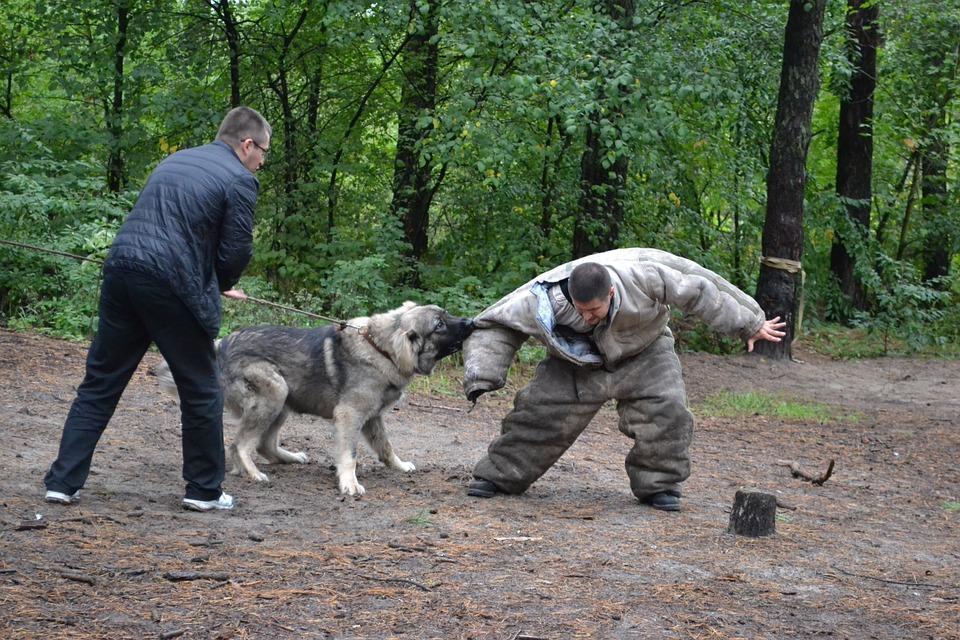Levels of Dog Bites - The Dunbar Bite Scale



See files for Dogs
Dog bite levels can cause varying degrees of damage to a person or animal. Our puppies will often nip at us playfully as they are exploring their environment and testing their boundaries. This is a normal part of canine development and something we often find amusing. Compare this to a vicious attack by a large dog which causes a serious wound. This is far from amusing and poses a serious public health risk. For this reason, the canine behaviorist and dog trainer Dr. Ian Dunbar has devised a system to classify dog bites. Although the system is not infallible and there are variations, it is a good way to check the severity of the the injury.
If you have been bitten by a dog, you should know the 6 levels of dog bites according to the Dunbar bite scale. AnimalWised explains these 6 levels and what sort of action is required to prevent serious injury.
- The Dunbar bite scale
- Level 1: aggressive but no skin contact
- Level 2: teeth make contact, but do not break the skin
- Level 3: a single bite with shallow wounds
- Level 4: a single bite with deep wounds
- Level 5: multiple bites with deep wounds
- Level 6: death of the victim and/or flesh consumed
- Usefulness of bite classification
The Dunbar bite scale
A happy and healthy dog with no reason to feel threatened or insecure has no reason to bite. While the many factors which lead to a dog biting someone may be complicated, there is usually a reason behind the behavior. These are multi-faceted, but their training, socialization and education are usually the most important.
Dr. Ian Dunbar's bite scale takes into consideration both the reasons why a dog may bite a human and what can be done about it. The dog bite levels on the Dunbar scale are the following:
- Level 1: aggressive but no skin contact.
- Level 2: teeth make contact, but do not break the skin.
- Level 3: a single bite with shallow wounds.
- Level 4: a single bite with deep wounds.
- Level 5: multiple bites with deep wounds.
- Level 6: death of the victim and/or flesh consumed.
Bite inhibition in dogs in an important part of canine education when we adopt a dog into the home. This is the process whereby they learn to grasp someone or something with their mouth, but know not to bite hard. The following levels range from dogs with bite inhibition to those with none. Keep reading to find out more about the Dunbar bite scale for dogs.
Level 1: aggressive but no skin contact
While we are discussing the different levels of dog biting, the first does not actually involve biting the skin of the person. It is generally an aggressive display which includes biting at the air and grunting, but not any physical damage. Frequently, they involve aggressive signals such as showing their teeth and growling, although they may not even approach the person. However, if the dog snaps and bites the person's clothing without harming their body, this would fall into the level 1 category.
Signs of aggression may seem troublesome, but if a dog uses level 1 biting, it may be simply using its canine instincts to signal fear. Over 99% of altercations which a dog do not go past level 1[1]. The dog may be scared for valid reasons if someone is trying to attack them. However, the majority of cases are to do with insecurity in the dog. Addressing the cause of the insecurity and implementing training is usually enough to prevent this kind of behavior.
Biting behavior does not only occur towards humans. Learn more with our guide explaining what happens when a dog bites a toad.

Level 2: teeth make contact, but do not break the skin
With this type of biting the victim may have teeth marks, but they will not have any perforation in their skin. Virtually all people who work extensively with dogs have incurred this type of bite. These include trainers, vets, groomers and even many dog guardians. Although the dog may have bite inhibition, the person may receive bite marks or scratches. Superficial marks may appear on the skin, but the skin should not be perforated.
In these cases, the dog is sending a very serious signal that it is being subjected to some type of stress. Furthermore, it is unable to channel this stress into a healthy outlet. The dog is not intending to cause any harm and it is not a dangerous dog. On the contrary, biting without breaking the skin shows the dog has learned how to inhibit their bit properly. It should not even require first aid.
Regardless, the dog is being aggressive and we need to address this problem. We can do this by determining the cause of their stress and eliminating it from their environment. However, if the problem is not solved, aggressiveness can increase and result in a higher numbered bite on the Dunbar scale.
Level 3: a single bite with shallow wounds
The third dog bite level of the Dunbar scale results in a bite which causes between one and 4 superficial perforations of the skin. The wounds do not exceed deeper and half the length of the canine teeth. There may be lacerations in one direction as the victim or the dog tries to back away from the altercation.
This type of bite is variable and can have many causes. Dogs may bite because:
- They are afraid
- Rough play escalates into aggression
- The dog's predatory instinct is triggered
- They received trauma
- Poor socialization
- Other causes
Beyond the causes and context of the situation, any dog which causes a level 3 bite should be taken to a veterinarian or canine educator. The treatment received will depend on the reasons for the incident. If the cause is clinical, they will be required to see a veterinarian specialized in canine behavior. If the cause is a behavioral problem, the expertise of a dog trainer or canine ethologist will be required.
Dogs whose bites fall into this category usually have poor bite inhibition, poor dog socialization or some other serious problem. The problem can often be solved, but it must be dealt with by people experienced in canine aggression.
As a note, the type of training is important. Some trainers are proponents of dominance theory. Although effective in the short-term, dominance training often has negative consequences in the long-term.
Dog aggression is a serious problem, but it too runs on a sliding scale. Learn more with our article explaining the 12 levels of dog aggression.

Level 4: a single bite with deep wounds
When the dog bites only once, but the wounds are deep, it will be considered a level 4 bite. The bite may cause one to four perforations which are deeper than half the length of the canine tooth. Injuries may go in both directions, caused by the victim removing their hand while being bitten or the dog shaking their head when biting. In some cases, these bites may be caused by predatory instincts. Dogs shake their heads when biting to cause maximum damage to their prey, so these are serious bites.
The cause od this dog bite level is also often fear. It usually occurs in dogs which try to defend themselves against what they perceive as a serious threat, although they evade the situation after the first attack. Any dog which has given a perosn a fourth level bite needs to be seen by a professional trainer. As with dogs which have perpetrated third level bites, they will need either clinical or behavioral treatment methods, whichever is most appropriate.
In some canine sports such as schutzhund or mondioring, bites similar to the fourth level are actively sought after as a function of the game. However, they are directed toward people wearing a protective sleeve or suit. Dogs which are properly trained to play these sports are not dangerous and have bite inhibition. These dogs know they are only authorized to bite the protective suits and do not attack unprotected regions of the body.
However, there are too many dogs which are improperly trained for attack. They do not release their bite on command and ma not have control over their predatory instincts. These dogs are dangerous and should not be involved in this kind of training or gameplay.
Learn more about why a dog is afraid of people in our related guide.
Level 5: multiple bites with deep wounds
Fifth-level bites cause deep wounds, similar to the previous stage. However, they occur multiple times and can happen in multiple regions. This could be due to the dog making multiple bites in a single attack or due to being attacked several times over a prolonged incident
Dogs which perform fifth-level bites on the scale are considered types of dangerous dogs. Their rehabilitation is possible, but always under constant supervision by an ethologist, veterinary specialist or dog trainer.
There may also be mitigating circumstances for dog bites of this type. A dog that is mistreated and bites to defend itself should not be considered dangerous. This may also be applicable to situations in which the dog bites to defend their owner from an attack.
Level 6: death of the victim and/or flesh consumed
The sixth and final level of dog bite is the most severe. It is also important to note this level is very rare. A dog reaches the sixth level when they have resulted in the death of the victim or if they have consumed flesh which they have removed from the victim. The consumption of human meat from a pre-deceased corpse does not fall into this category.
A dog or group of dogs which is involved in the death of a person must be evaluated. However, for both levels 5 and 6, Dr. Dunbar himself claims the dogs are ‘simply not safe around people’ and even goes as far to recommend euthanasia for the dog[2]. In these cases, the authorities will likely get involved to determine responsibility for the death.

Usefulness of bite classification
This classification, as with all those which have to do with animal behavior, is a general guide. It must be considered in the specific context of a given situation where a dog bites a person. We also need to rely on experts and their assessment of a given situations which involves canine aggression. It is not a blanket approach which is applicable to every case of a dog bite.
The dogs which have bitten at the first two levels should be relatively easy to solve, especially by competent professionals. The result may need to be temporary or permanent changes to their environment. Level 3 and 4 bites require greater precautions and above this are serious incidents which often lead to criminal prosecution.

If you want to read similar articles to Levels of Dog Bites - The Dunbar Bite Scale, we recommend you visit our Behavioral problems category.
1. Caffrey, N., et al. (2019). Insights about the Epidemiology of Dog Bites in a Canadian City Using a Dog Aggression Scale and Administrative Data. Animals (Basel), 9(6), 324.
https://www.ncbi.nlm.nih.gov/pmc/articles/PMC6617111/
2. Association of Professional Dog Trainers (n.d.) An assessment of the severity of biting problems based on an objective evaluation of wound pathology. https://apdt.com/wp-content/uploads/2017/01/ian-dunbar-dog-bite-scale.pdf







 I am a dog!!!!!!!!!!!!!!!!!!!!!!!!!!!!!!!!!!!!!
I am a dog!!!!!!!!!!!!!!!!!!!!!!!!!!!!!!!!!!!!!



